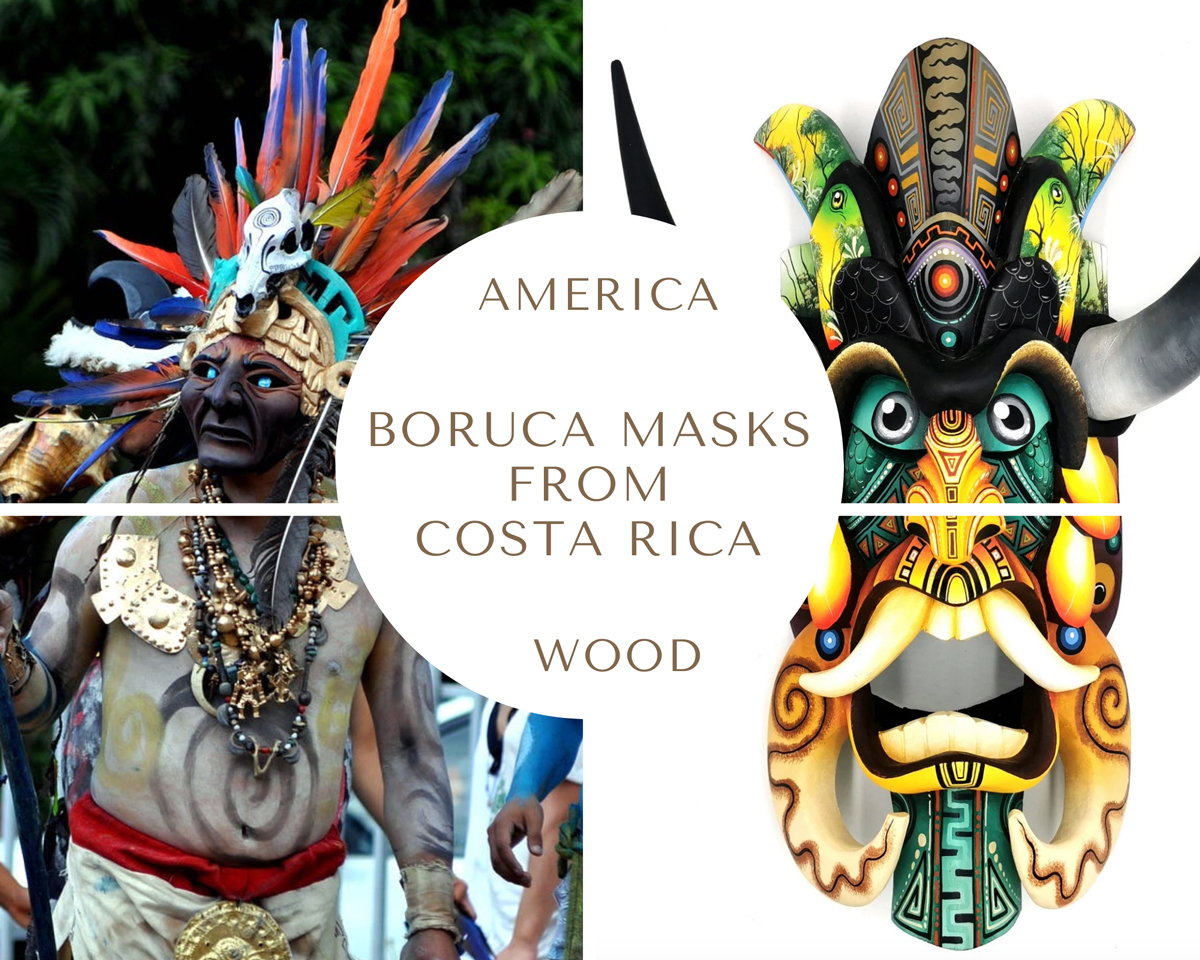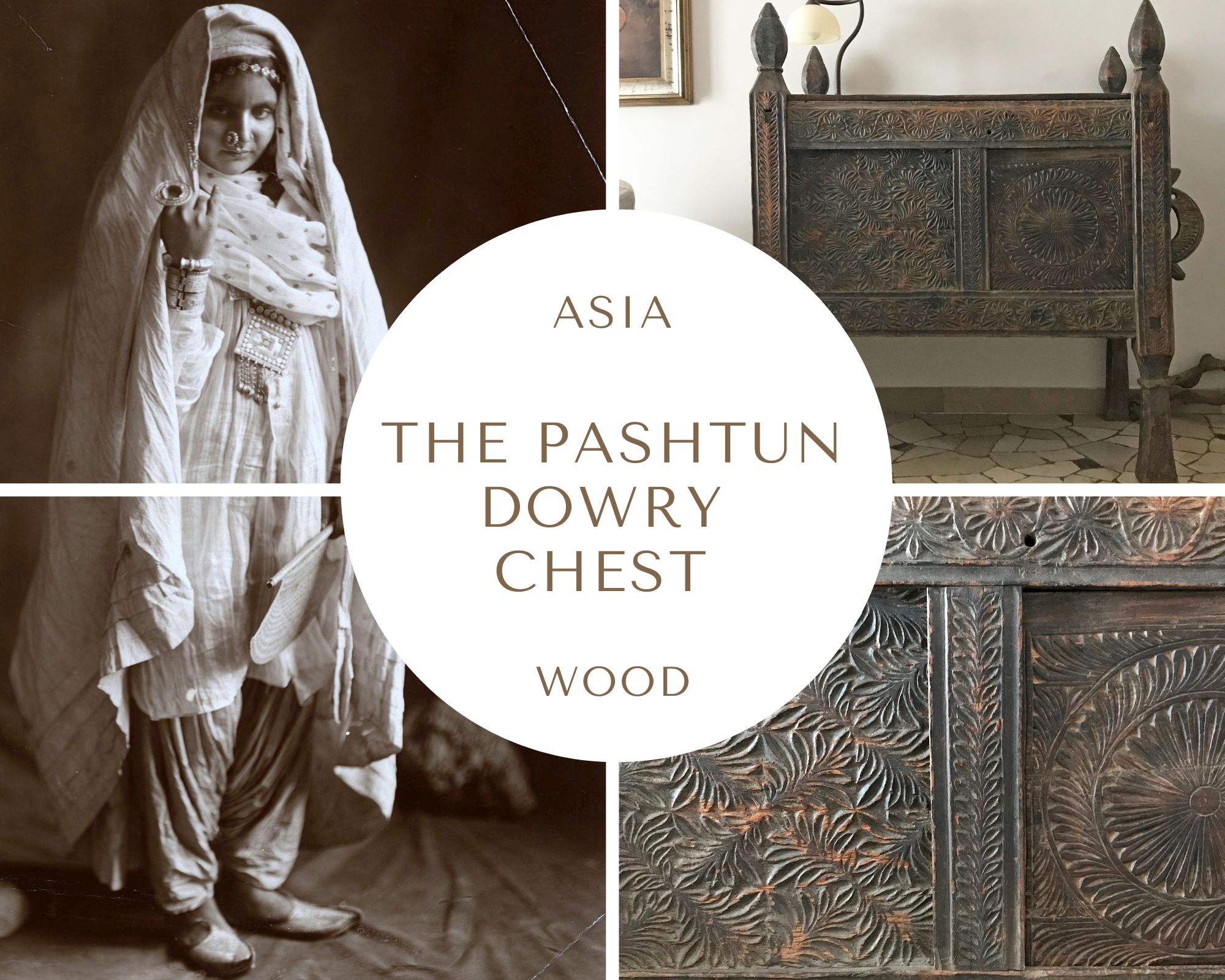MASKS OF A PREHISTORIC GOD
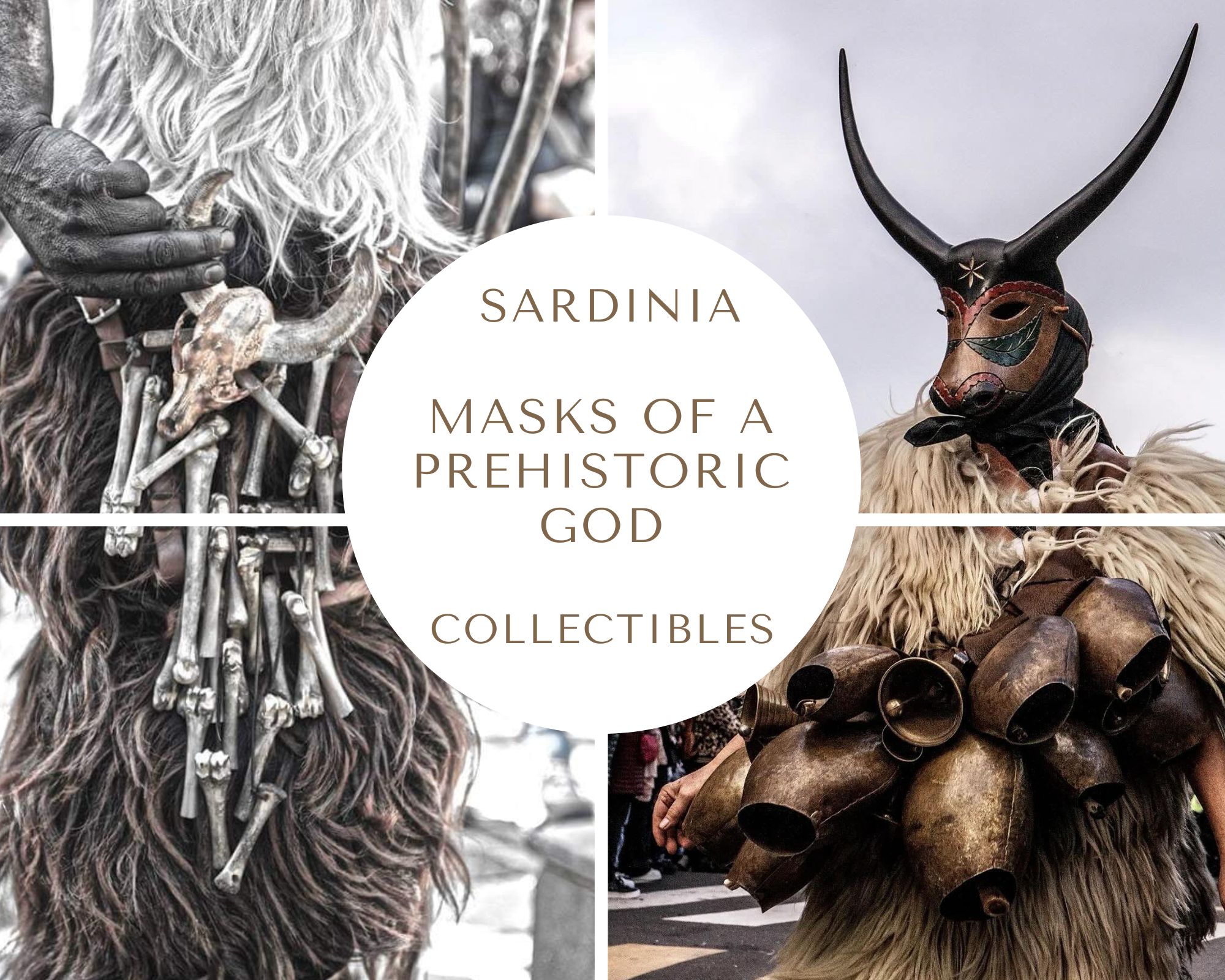
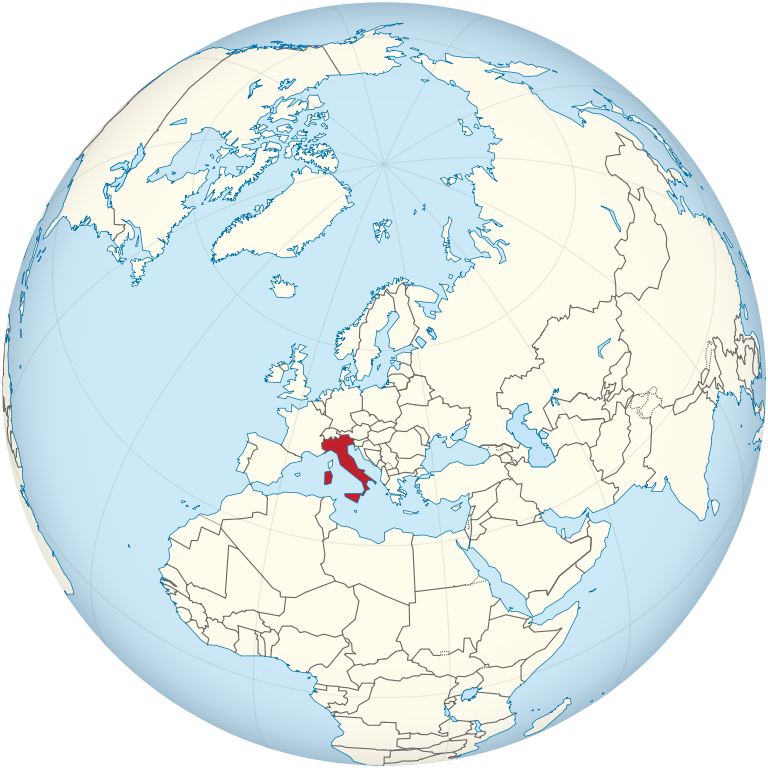
Italy on the globe
Source: Wikimedia Commons
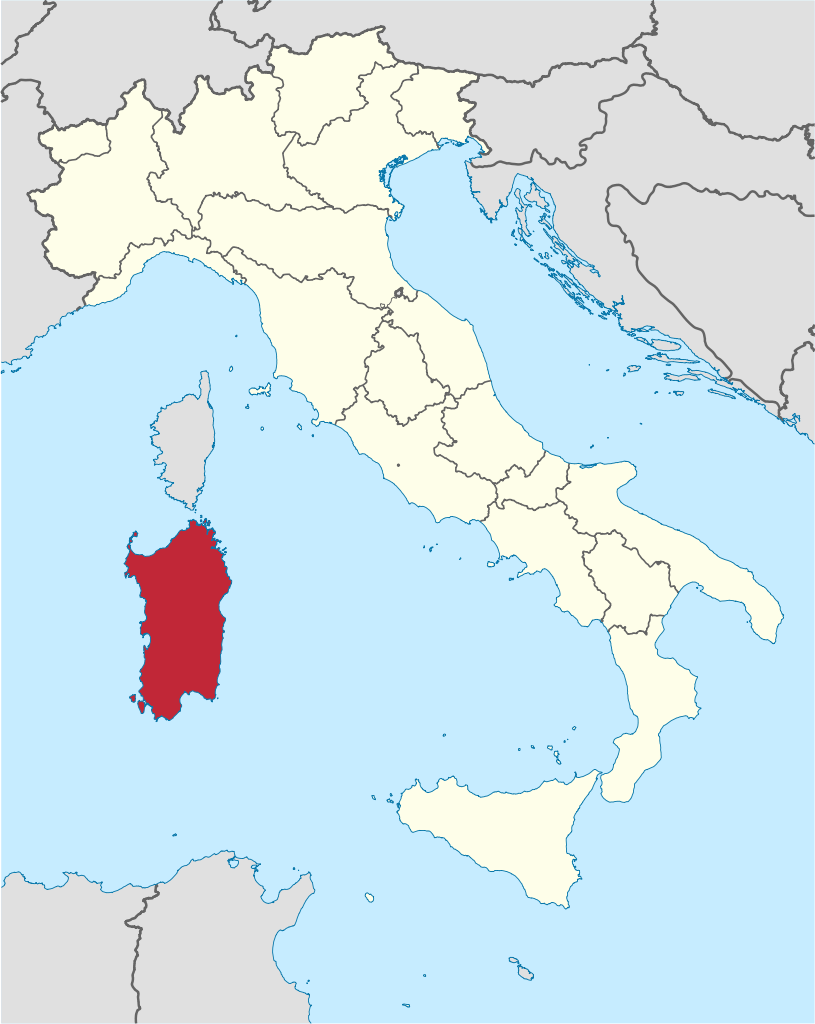
The Italian island of Sardinia
Under the terms of the GNU Free Documentation License
MASKS OF A PREHISTORIC GOD
Preface: The words in bold and italics are not Italian, but Sardinian. Sardinian (sa limba sarda) is a Romance language still spoken on the western Mediterranean island of Sardinia. According to many Romance linguists, it’s the closest language to Latin of all its linguistic descendants.
____
A boe breaks away from the group and kicks wildly at the crowd. His legs and torso are covered in an unblemished sheep’s hide, his face hidden beneath a taurine mask with long, menacing horns. From his left shoulder to his right hip runs a row of cowbells (brunzittos) and rattles (sonazzas)—35 kilos of metal—that jolt and clash with each jump, creating a rhythmic and eerie clamor.
Suddenly, on the road, sos merdùles appear—the shepherds armed with a staff (mazzuccu) and a whip (soca). They are draped in animal hides and wear a caratza, a mask as black as the night, twisting the human face into a grotesque grimace.
The rebellious boe grows restless, charges, throws itself to the ground; the merdùle chases it, strikes it. Man and beast struggle, the rhythm intensifies, the merdùle shouts, the boe goes mad—then, exhausted, it surrenders.
Man has tamed the beast. He has won.
The ‘fight’ of Boes and Merdules by Associazione Culturale Boes e Mrerdules, Ottana (NU, Sardinia)
THE SARDINIAN CARNIVAL, AN ANCIENT RITE OF DEATH AND REBIRTH OF THE GOD DIONYSUS
Sos boes and sos merdùles have for millennia given life to the carnival of Ottana (in the province of Nuoro), a celebration that has nothing to do with Renaissance carnival traditions and songs or the masks of the Italian Commedia dell’Arte, such as Arlecchino (Harlequin).
«The carnival that survives on the island –writes the Italian scholar Dolores Turchi–presents itself with deeply archaic traits»: it’s a tragic rite that reenacts the eternal cycle of death and rebirth of Dionysus, the ancient deity of the Mediterranean agro-pastoral world, who embodies the primordial, chaotic vitality of nature. The term used on the island for carnival is carrasecare or carrasegare, meaning “living flesh to be torn apart,” an allusion to the ancient Dionysian ritual of dismembering live children and young bulls in memory of the god torn to pieces by the Titans.
These sacred, bloody and violent celebrations arrived in Sardinia between the 14th and 13th centuries B.C. under Mycenaean influence, merging with the fertility rites of the Nuragic era. Although softened by centuries of Christianity, they have survived to the present day. The boe of Ottana is Dionysus in the form of the bull-god, a manifestation of the chaotic energy of nature – elsewhere depicted as a deer-god or a goat-god.

Boes and Merdules in Ottana, 2014. Photo by Gianni Careddu.
Licensed under the Creative Commons Attribution-Share Alike 3.0Unported.
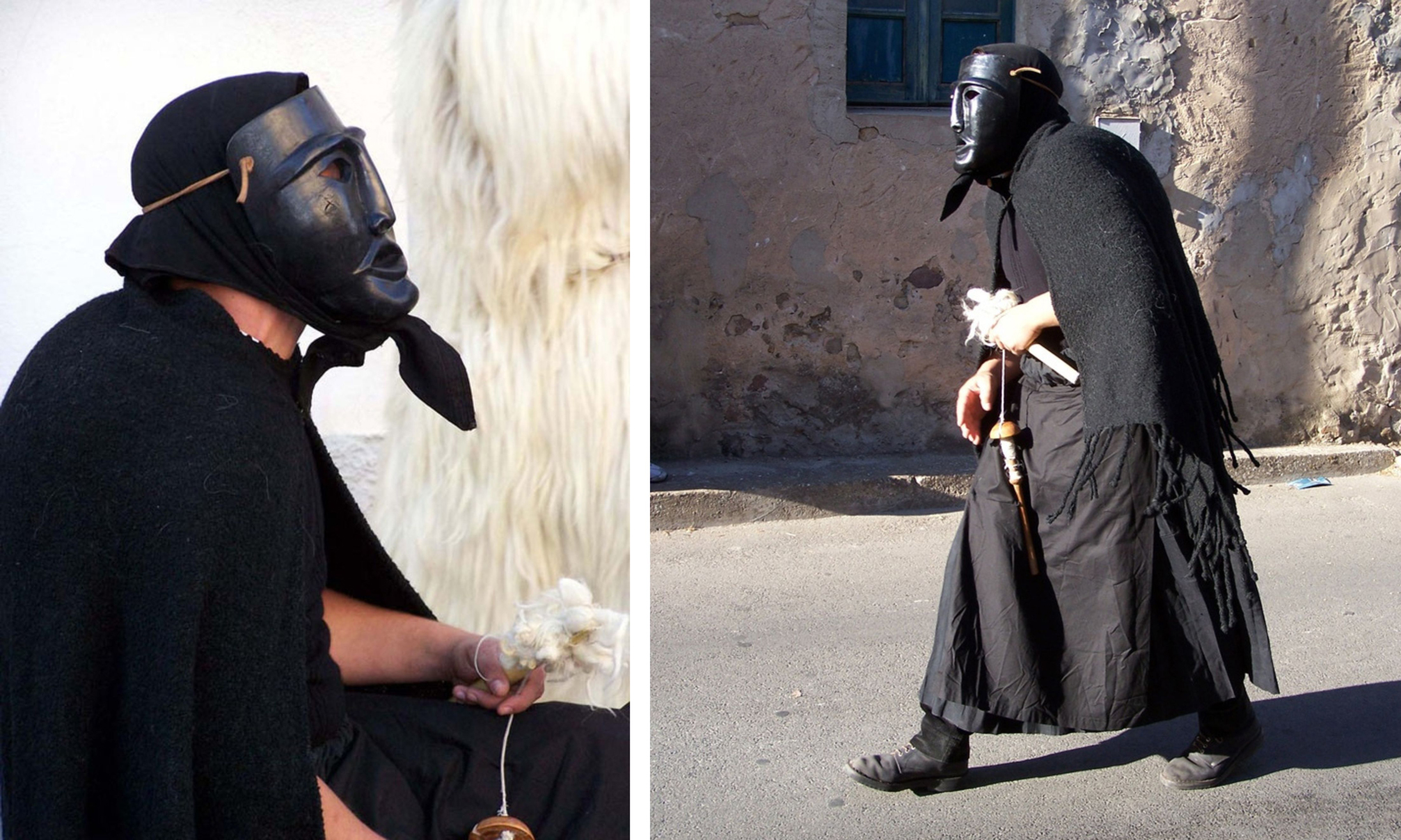
Sa Filonzàna is an ancient carnival mask from Ottana that often appears alongside boes and merdùles. She is an old woman holding a spindle and endlessly spinning the thread of human life: she is the island incarnation of the Greek Moirai or the Parcae of Roman mythology. The Greek Moirai and the Roman Parcae were powerful goddesses of fate, spinning, measuring, and cutting the thread of human life. The Moirai—Clotho, Lachesis, and Atropos—controlled destiny with unyielding precision, while the Parcae, their Roman counterparts, carried out a similar role, though later influenced by ideas of divine mercy. Neither gods nor mortals could escape their will.
As said, the boe of Ottana is Dionysus in the form of the bull-god, elsewhere depicted as a deer-god or a goat-god. Su corriòlo is the ancient mask of the Carrasecare of the town of Neoneli, in the historical region of Barigadu: the animal god wears sheepskin, but on his headdress he wears the striking antlers of a fallow deer or a stag. A porcupine skin protrudes from his shoulders, and on his back, instead of cowbells, sad clusters of bones rattle, a clear allusion to the eternal cycle of natural fertility.
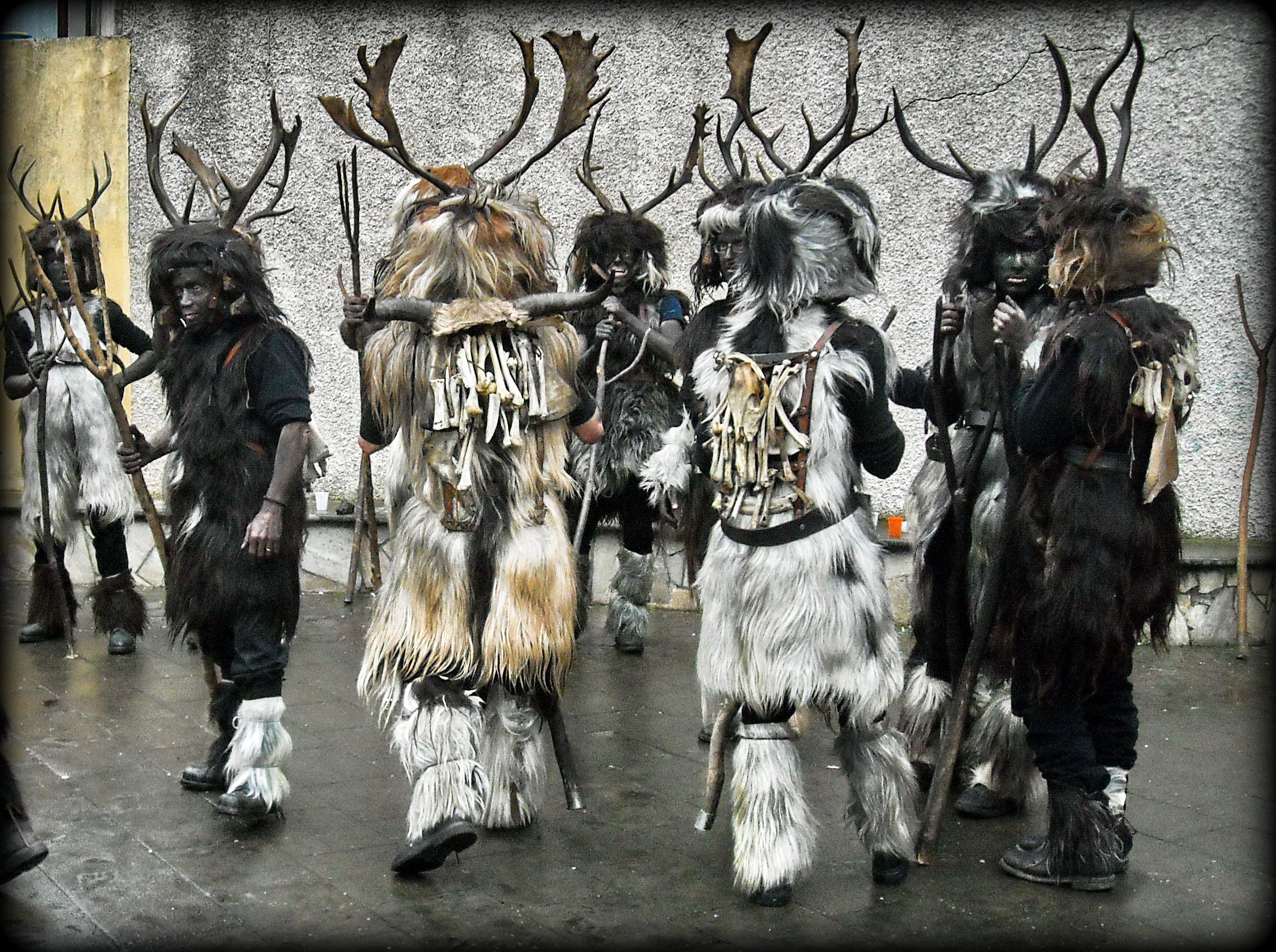
Sos corriolos (su corriolo is singular), Neoneli (Oristano, Sardinia), 2012. Photo by Cristiano Cani.
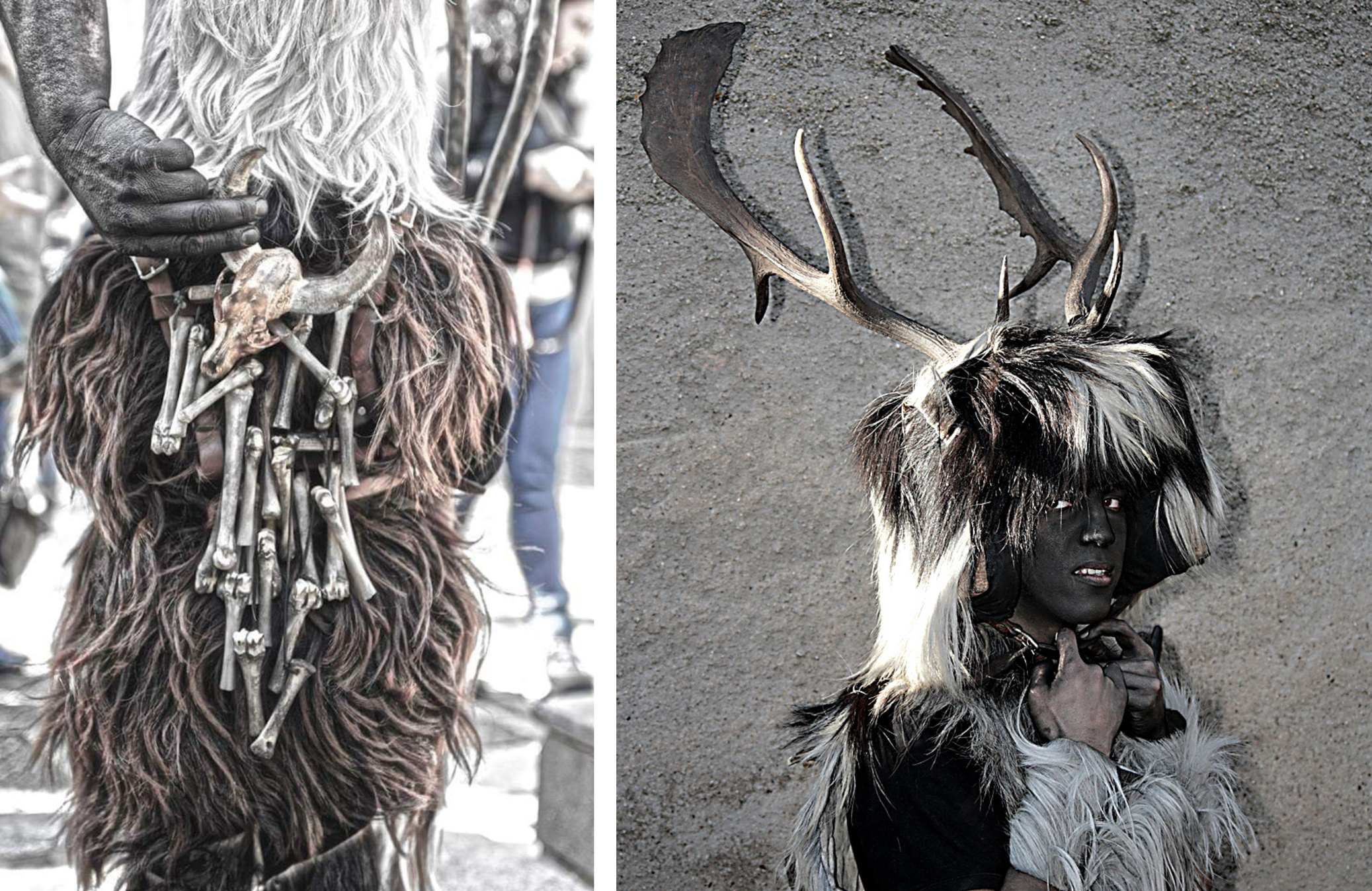
Su Corriolo’s face is always painted black, he wears deer antlers on his head and is always covered with different kinds of skin. Photo on the right by Pietro Melis.
The symbolism of deer antlers is easy to interpret: the deer periodically renews its antlers, and they have often been seen as a symbol of life regenerating itself, alternating between death and rebirth. Even the Celtic god Cernunnos – deity of fertility, virility, hunting, war, abundance, animals, the wild, as well as death and the afterlife – was depicted with stag antlers.
«Sos Corriolos are armed with pitchforks and shake the bones they carry on their shoulders as they leap through the snow like young deer» writes folk traditions scholar Dolores Turchi (2009). «Sos Corriolos wore goatskins, a belt of braided snake skin, and two porcupine skins on their shoulders, as well as wooden-soled shoes that echoed like drums with each step. It is not surprising that they wore belts of snake skin. These were common snakes, which in Sardinia had different meanings, mostly positive in ancient times. The snake was considered a symbol of death and rebirth because it renews itself every year by shedding its skin. Until a few decades ago, when farmers and shepherds found a shed snake skin, they would carefully fold it and keep it in their purse, believing that it would bring them good luck.»
THE MASK: A PRIMAL FUSION OF DIVINE, HUMAN, AND ANIMAL FORCE
In Samugheo, a small town in the province of Oristano, Dionysus dies and is reborn in the guise of s’urtzu, the ogre—an unsettling zoomorphic mask covered in the entire hide of a black goat, head included. Here, the god perishes at the hands of s’omadore (the tamer), while his followers, the mamutzones, hurl themselves into a frenzied dance around the fire.
BELOW
S’Omadore represents the shepherd who guides s’Urtzu and pushes him forward after catching him with a rope (sa soga). The objects that define his figure are, besides the rope, a staff, a goad and a chain. He wears a long black cloak with a hood and carries a gourd filled with wine around his neck. The mask of s’Urtzu features the full hide of a black billy goat covering his head and shoulders, while his chest is draped in goatskins. He wears a single heavy cowbell – a distinctive feature of the leading goat in a herd. In the last photo on the right, s’Urtzu is captured by the rope and thrown to the ground by s’Omadore. Text and photos: Sardinia Digital Library.
In Orani, in the Nuoro region, the traditional caratza is su bundhu, an anthropo-bovine mask (horns again!) symbolizing the wind, the breath of life and death, and the relentless primordial cycle.
Su Bundhu, also spelled Su Bundu, is an enigmatic figure representing a creature that is half human and half bovine, embodying the deep connection between agricultural traditions and carnival celebrations in Sardinian culture.
Crafted from cork, it covers the entire face and shows human facial features combined with bovine elements, most notably horns; a pronounced hooked nose and sloping moustache and an enigmatic, somewhat frightening appearance. Traditionally painted red, believed to have originally been colored with animal blood. A modern variant is made of natural, carved cork that highlights the facial features.
Su Bundu plays a central role in the Orani Carnival celebrations, which begin on January 16th with the bonfire of Sant’Antonio and continue through the main carnival days. The mask and its associated rituals have deep agricultural and spiritual significance. During carnival processions, Sos Bundos enact planting rituals, using su trivuthu to symbolically plant seeds. They strike or sting onlookers with their trident to invite them to participate in propitiatory dances for an abundant harvest, and according to local tradition, a peasant dressed as Bundu once convinced evil spirits to respect humans and their harvests during a stormy night.
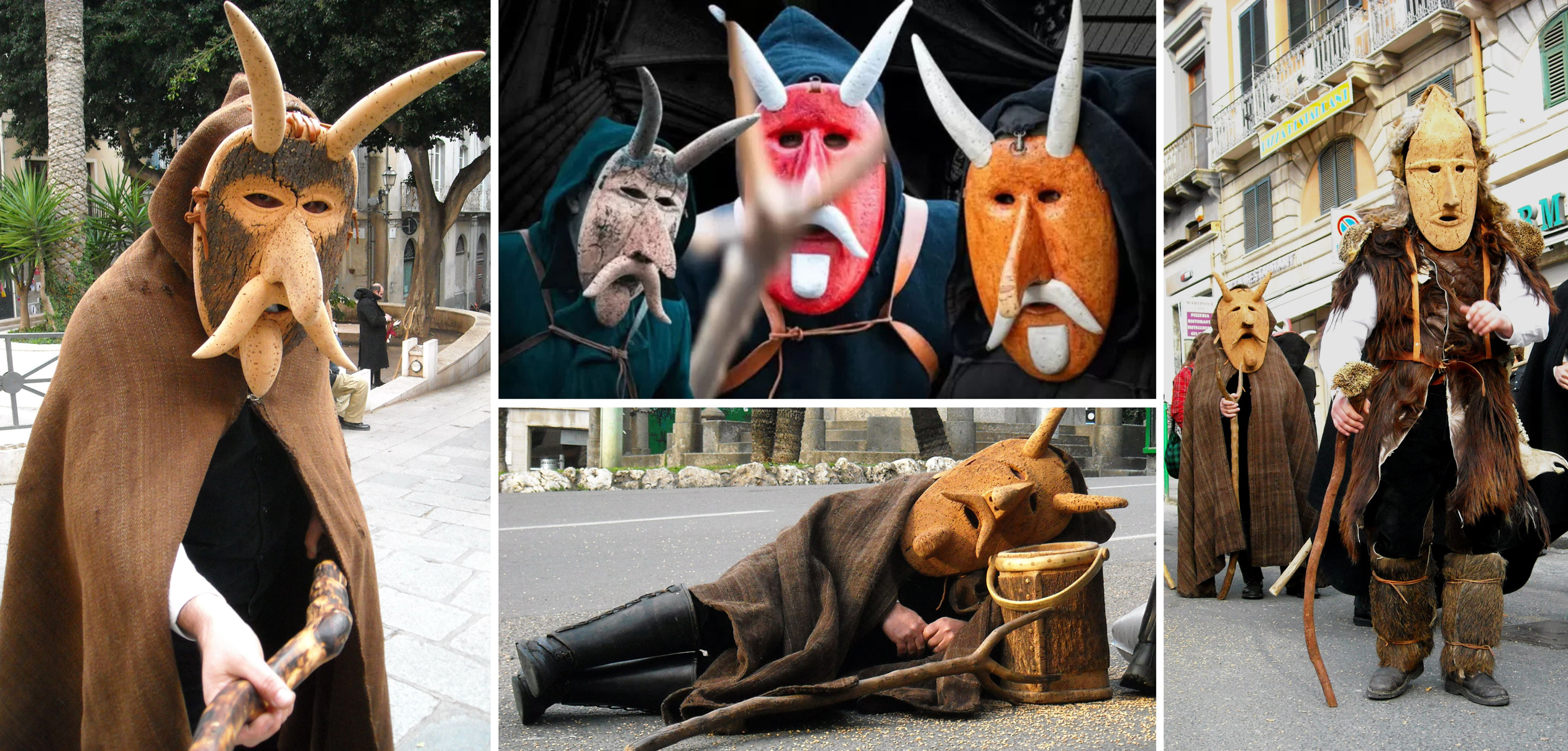
Sos Bundhos, Su Carrasecare de Orani. Photos by Cristiano Cani, Orani (NU), 2009.
The Sardinian carnival masks and masquerades preserve intact the gestures, the ecstatic rhythms and the apotropaic and fertility symbols of the ancient Dionysian cults. What they have lost, however, is their bloodthirsty ferocity-a change brought about by Christianity. As early as the 4th century, Saint Augustine thundered against the pre-Christian disguises worn during the January Calends, in which men wear animal skins, put animal heads on their own, and transform themselves into beasts. Blood no longer flows – red wine has taken its place – but the masks remain as tangible relics of the island’s millennia-old traditions.
«The mask allowed primitive man to transcend space and time and to immerse himself in the divine, mystical and sacred realm», explains Sardinian photographer Adriano Mauri. «Today, it is the young people who breathe life into these masks through the pantomime of carnival. I have often photographed them, with and without their caratza (mask), and for all of them, the transformation into the caratza remains an honor, the most intimate expression of their bond with their mother island».
FOR THOSE TRAVELING TO SARDINIA
ARTISTS AND CRAFTSMEN
Bottega Artistica di Carmine Piras, via Ghilarza 25, Oristano.
Franco Maritato, piazza S. Antonio 6, Ottana (NU).
Angelo Denti, via E. Mattei 18, Ottana (NU).
Mario Cossu, via Pirisi 38, Sarule (NU).
Mario MorittU, Orani (NU).
Felice Murgia, via Rinascita 15, Neoneli (OR).
CULTURAL GROUPS
Boes e Merdules, via E.Lussu 16, Ottana (NU).
Mamutzones de Samugheo, Samugheo (OR).
Mamutzones Antigos, Samugheo (OR).
Sos Corriòlos de Neoneli, via S.Satta 1, Neoneli (OR).
Every Year, Men Turn Into Monsters for This Ancient Pagan Ritual | Short Film Showcase by National Geographic.
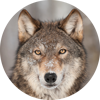
Alyx Becerra
OUR SERVICES
DO YOU NEED ANY HELP?
Did you inherit from your aunt a tribal mask, a stool, a vase, a rug, an ethnic item you don’t know what it is?
Did you find in a trunk an ethnic mysterious item you don’t even know how to describe?
Would you like to know if it’s worth something or is a worthless souvenir?
Would you like to know what it is exactly and if / how / where you might sell it?

